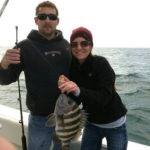
Long trip or short, Murrells Inlet is starting point
Offshore in February? Sounds crazy to some, but others know very well that February fishing is great off the coast, starting just a few miles out all the way to the Gulf Stream. A great starting point for winter action is South Carolina’s seafood capital, Murrells Inlet.
Heading out of Murrells Inlet, anglers do not have to go far before hitting good fishing. According to Capt. Ned Rogers of R&R Fishing Charters, it’s a relatively short ride to the closest fish.
“Sheepshead fishing is great on the nearshore reefs and wrecks four to 10 miles out,” he said.
Sheepshead are notorious for the short bite; anglers experiencing sheepshead fishing for the first time often find it a frustrating task. The bite is felt easy enough, but making the hookset in time proves nearly impossible.
“I find the most-productive technique is eliminating slack between the hook and the weight,” said Rogers (843-460-0186). “Instead of a traditional Carolina rig, I’ll use a ½- to 1-ounce jig head, depending on conditions, tied directly to my line.”
One look inside a sheepshead’s mouth, and it doesn’t take too much imagination to guess how they got their name. Because the jaws and teeth are designed to break off barnacles and crush crabs, Rogers recommends a strong hook.
“Use a sturdy hook, because sheepshead have a light bite, but a very strong mouth, and (they) will bite through a light hook.”
Rogers recommends a vertical presentation for best results. He accomplishes this by positioning the boat directly above the structure he intends to fish. Also, targeting the slower currents a few hours on either side of dead high or low makes getting the bait vertical much easier.
“Let the line hit bottom, and then reel it up just a little so the line stays tight but the bait stays in the strike zone,” he said.
Traditionally, fiddler crabs are the bait of choice for sheepshead, but they hibernate during the winter, making availability a problem unless imported by a local bait shop. Another option that is readily available, and just as effective, is barnacles. By scraping them off of the side of pilings during lower tides, anglers can gather more than enough for a day of sheepshead fishing. However, barnacles are more difficult to place on a hook, so anglers should take enough of them to make up for lost bait; maybe twice as many barnacles compared to fiddlers for the same amount of time.
For fishermen more interested in what’s swimming near the Gulf Stream, make an offshore journey of approximately 60 miles to places where blackfin tuna and wahoo await. Trolling skirted ballyhoo is by far the most-reliable method for attracting offshore pelagics. Rogers mostly uses 30-wide reels and trolling rods, but also includes a few 50-wides for outriggers and long centers.
“Thirty-wides will work fine, but 50s allow you to get the fish in a little quicker when they are far out, so too much time in not wasted fighting a single fish,” he said.
Rogers prefers a few of his trolling baits down deep, but doesn’t use a downrigger. He chooses a more stealthy 30- or 40-foot deep planer matched with a reel loaded with monel line and 50 feet of 130- to 150-pound fluorocarbon leader.
“The steel monel wire cuts through the water much more silently than a heavy downrigger line does, especially at faster trolling speeds.”
Rogers targets ledges in 140 to 250 feet of water, and he uses a zig-zag trolling pattern. Once he finds fish, his trolling pattern becomes much tighter, concentrating on the most-productive spots. Winter wahoo range from 40 to 60 pounds — with the occasional bigger fish — and blackfin ranging from five to 30 pounds are caught; an occasional dolphin is not unheard of in February.
Any trip — offshore or nearshore — is preceded by a thorough weather check. Having seas build when you’re several hours away from land is a scary and quite dangerous situation. How rough “too rough” actually is depends greatly on the size and type of the vessel, and boaters must know the capabilities of their boats. What is okay for a 35-foot sportfisher may be entirely too much for a 24-foot center console, even if fishing just a few miles off the beach.
“Going offshore all depends on the winds,” Rogers said. “Low winds result in flat rollers offshore that are not much of a concern, but when the winds hit 15 to 20 knots, seas really start to stack up. Ten knots or less and variable is usually the ticket.”
So Murrells Inlet lives up to its nickname even in February, when many fishermen dare not venture far from the warmth of home. It’s a great starting point for catching some of South Carolina’s best seafood.





Be the first to comment